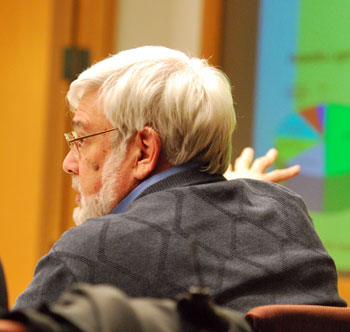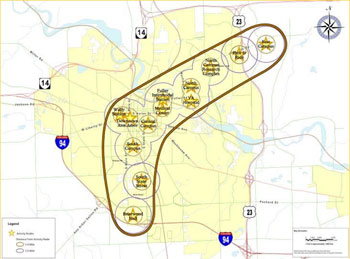AATA: Transit Study, Planning Updates
Ann Arbor Transportation Authority board meeting (Jan. 20, 2011): The AATA’s first monthly board meeting of the year featured a presentation on a connector feasibility study on the Plymouth and State street corridors. The study is now nearing completion.

AATA board chair Jesse Bernstein points to a pie chart projected on the screen as part of the presentation the board heard about the Plymouth-State street corridor connector study. (Photo by the writer.)
In their one main business item, the board approved the capital and categorical grants program for 2011-15. The program will form the basis for upcoming state and federal grant applications.
Board member David Nacht prefaced the discussion of the connector feasibility study by encouraging his colleagues to share their thoughts on it – because the board had argued a long time about whether to help fund the $640,000 study, along with the other partners: the city of Ann Arbor; the Ann Arbor Downtown Development Authority; and the University of Michigan.
In the course of their discussion, the board touched on another major planning initiative: the countywide transportation master planning process.
Beginning Jan. 31, the AATA is launching the final round of public engagement meetings to develop a countywide plan for transit. Currently the AATA is funded by an Ann Arbor transit millage, plus purchase of service (POS) agreements with other municipalities. Voters in the city of Ypsilanti passed a millage in November 2010 that will cover most of the cost of Ypsilanti’s POS, for example.
Twenty additional meetings on the countywide planning effort are scheduled at locations throughout the county, to get feedback on three transit scenarios developed so far. Transit options in the three scenarios – which the AATA has labeled Lifeline Plus, Accessible County, and Smart Growth – are nested subsets, starting with Lifeline Plus as a base, which expands on existing services and focuses on services for seniors and disabled people.
According to representatives of the AATA and its consultant on the project, Steer Davies Gleave (SDG), the goal of the last phrase of public interactions is not for people to appear at the meetings and simply vote for their preferred option. They’re interested in hearing what options from the various scenarios might be combined to build a “preferred scenario.” [Full Story]




